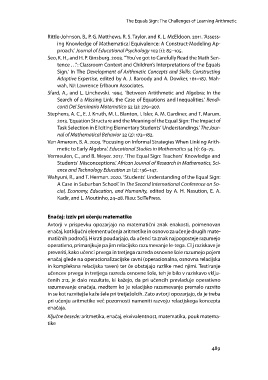Page 489 - Istenič Andreja, Gačnik Mateja, Horvat Barbara, Kukanja Gabrijelčič Mojca, Kiswarday Vanja Riccarda, Lebeničnik Maja, Mezgec Maja, Volk Marina. Ur. 2023. Vzgoja in izobraževanje med preteklostjo in prihodnostjo. Koper: Založba Univerze na Primorskem
P. 489
The Equals Sign: The Challenges of Learning Arithmetic
Rittle-Johnson, B., P. G. Matthews, R. S. Taylor, and K. L. McEldoon. 2011. ‘Assess-
ing Knowledge of Mathematical Equivalence: A Construct-Modeling Ap-
proach.’ Journal of Educational Psychology 103 (1): 85–105.
Seo, K. H., and H. P. Ginsburg. 2003. ‘“You’ve got to Carefully Read the Math Sen-
tence . . .”: Classroom Context and Children’s Interpretations of the Equals
Sign.’ In The Development of Arithmetic Concepts and Skills: Constructing
Adaptive Expertise, edited by A. J. Baroody and A. Dowker, 161–187. Mah-
wah, NJ: Lawrence Erlbaum Associates.
Sfard, A., and L. Linchevski. 1994. ‘Between Artithmetic and Algebra: In the
Search of a Missing Link, the Case of Equations and Inequalities.’ Rendi-
conti Del Seminario Matematico 52 (3): 279–307.
Stephens, A. C., E. J. Knuth, M. L. Blanton, I. Isler, A. M. Gardiner, and T. Marum.
2013. ‘Equation Structure and the Meaning of the Equal Sign: The Impact of
Task Selection in Eliciting Elementary Students’ Understandings.’ The Jour-
nal of Mathematical Behavior 32 (2): 173–182.
Van Amerom, B. A. 2003. ‘Focusing on Informal Strategies When Linking Arith-
metic to Early Algebra.’ Educational Studies in Mathematics 54 (1): 63–75.
Vermeulen, C., and B. Meyer. 2017. ‘The Equal Sign: Teachers’ Knowledge and
Students’ Misconceptions.’ African Journal of Research in Mathematics, Sci-
ence and Technology Education 21 (2): 136–147.
Wahyuni, R., and T. Herman. 2020. ‘Students’ Understanding of the Equal Sign:
A Case in Suburban School.’ In The Second International Conference on So-
cial, Economy, Education, and Humanity, edited by A. H. Nasution, E. A.
Kadir, and L. Moutinho, 24–28. Riau: SciTePress.
Enačaj: izziv pri učenju matematike
Avtorji v prispevku opozarjajo na matematični znak enakosti, poimenovan
enačaj, kot ključni element učenja aritmetike in osnovo za učenje drugih mate-
matičnih področij. Hkrati poudarjajo, da učenci ta znak najpogosteje razumejo
operativno, primanjkuje pa jim relacijsko razumevanje le-tega. Cilj raziskave je
preveriti, kako učenci prvega in tretjega razreda osnovne šole razumejo pojem
enačaj glede na operacionalizacijske ravni (operacionalna, osnovna relacijska
in kompleksna relacijska raven) ter če obstajajo razlike med njimi. Testiranje
učencev prvega in tretjega razreda osnovne šole, teh je bilo v raziskavo vklju-
čenih 212, je dalo rezultate, ki kažejo, da pri učencih prevladuje operativno
razumevanje enačaja, medtem ko je relacijsko razumevanje premalo razvito
in se kot razvitejše kaže šele pri tretješolcih. Zato avtorji opozarjajo, da je treba
pri učenju aritmetike več pozornosti nameniti razvoju relacijskega koncepta
enačaja.
Ključne besede: aritmetika, enačaj, ekvivalentnost, matematika, pouk matema-
tike
489
Rittle-Johnson, B., P. G. Matthews, R. S. Taylor, and K. L. McEldoon. 2011. ‘Assess-
ing Knowledge of Mathematical Equivalence: A Construct-Modeling Ap-
proach.’ Journal of Educational Psychology 103 (1): 85–105.
Seo, K. H., and H. P. Ginsburg. 2003. ‘“You’ve got to Carefully Read the Math Sen-
tence . . .”: Classroom Context and Children’s Interpretations of the Equals
Sign.’ In The Development of Arithmetic Concepts and Skills: Constructing
Adaptive Expertise, edited by A. J. Baroody and A. Dowker, 161–187. Mah-
wah, NJ: Lawrence Erlbaum Associates.
Sfard, A., and L. Linchevski. 1994. ‘Between Artithmetic and Algebra: In the
Search of a Missing Link, the Case of Equations and Inequalities.’ Rendi-
conti Del Seminario Matematico 52 (3): 279–307.
Stephens, A. C., E. J. Knuth, M. L. Blanton, I. Isler, A. M. Gardiner, and T. Marum.
2013. ‘Equation Structure and the Meaning of the Equal Sign: The Impact of
Task Selection in Eliciting Elementary Students’ Understandings.’ The Jour-
nal of Mathematical Behavior 32 (2): 173–182.
Van Amerom, B. A. 2003. ‘Focusing on Informal Strategies When Linking Arith-
metic to Early Algebra.’ Educational Studies in Mathematics 54 (1): 63–75.
Vermeulen, C., and B. Meyer. 2017. ‘The Equal Sign: Teachers’ Knowledge and
Students’ Misconceptions.’ African Journal of Research in Mathematics, Sci-
ence and Technology Education 21 (2): 136–147.
Wahyuni, R., and T. Herman. 2020. ‘Students’ Understanding of the Equal Sign:
A Case in Suburban School.’ In The Second International Conference on So-
cial, Economy, Education, and Humanity, edited by A. H. Nasution, E. A.
Kadir, and L. Moutinho, 24–28. Riau: SciTePress.
Enačaj: izziv pri učenju matematike
Avtorji v prispevku opozarjajo na matematični znak enakosti, poimenovan
enačaj, kot ključni element učenja aritmetike in osnovo za učenje drugih mate-
matičnih področij. Hkrati poudarjajo, da učenci ta znak najpogosteje razumejo
operativno, primanjkuje pa jim relacijsko razumevanje le-tega. Cilj raziskave je
preveriti, kako učenci prvega in tretjega razreda osnovne šole razumejo pojem
enačaj glede na operacionalizacijske ravni (operacionalna, osnovna relacijska
in kompleksna relacijska raven) ter če obstajajo razlike med njimi. Testiranje
učencev prvega in tretjega razreda osnovne šole, teh je bilo v raziskavo vklju-
čenih 212, je dalo rezultate, ki kažejo, da pri učencih prevladuje operativno
razumevanje enačaja, medtem ko je relacijsko razumevanje premalo razvito
in se kot razvitejše kaže šele pri tretješolcih. Zato avtorji opozarjajo, da je treba
pri učenju aritmetike več pozornosti nameniti razvoju relacijskega koncepta
enačaja.
Ključne besede: aritmetika, enačaj, ekvivalentnost, matematika, pouk matema-
tike
489


